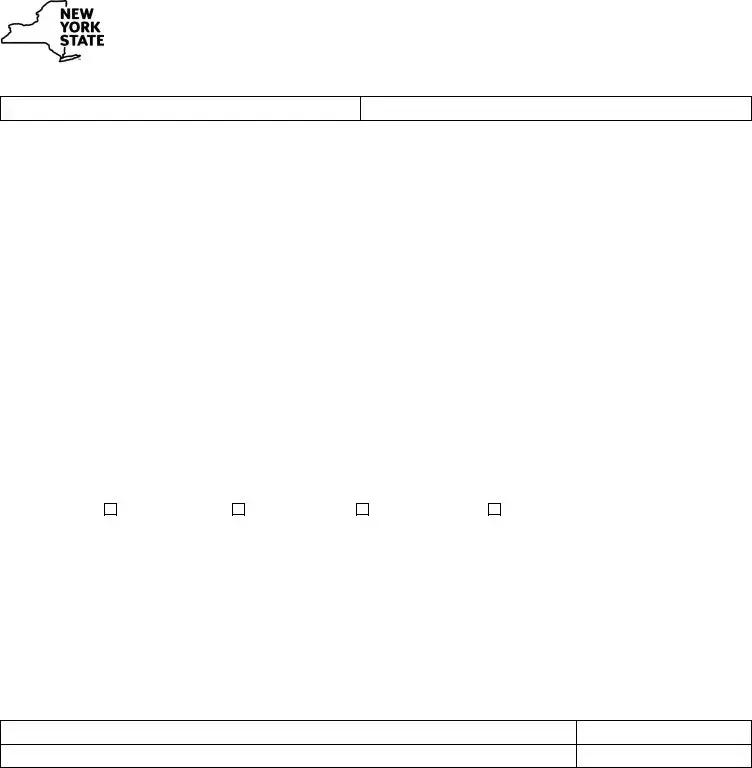One document similar to the NY TR-579-IT form is Form 8879, IRS e-file Signature Authorization. Like Form TR-579-IT, Form 8879 authorizes an electronic return originator (ERO) to e-file a tax return on behalf of a taxpayer. Both forms validate that the taxpayer has reviewed their return, it's accurate to the best of their knowledge, and they agree to the submission using an electronic signature. However, Form 8879 is for federal tax returns, while TR-579-IT is specifically for New York State tax returns.
Form W-9, Request for Taxpayer Identification Number and Certification, shares some similarities with the NY TR-579-IT form, principally in its role in the tax filing process. Both documents require the taxpayer’s signature and serve as declarations. Form W-9 is used to provide a taxpayer identification number to entities that will pay income to the signee, ensuring correct reporting to the IRS. Although it doesn’t authorize e-filing, it's a key component of tax documentation like the TR-579-IT.
Another document akin to the NY TR-579-IT is Form 4868, Application for Automatic Extension of Time To File U.S. Individual Income Tax Return. While Form 4868 does not authorize e-filing or electronic signatures, it is similar in that it interacts with the electronic filing system by allowing taxpayers more time to file their returns electronically. Both forms play pivotal roles in the e-filing process by either enabling the actual e-filing or facilitating the taxpayer’s needs surrounding the e-filing.
Form IT-201, Resident Income Tax Return, is directly related to the NY TR-579-IT as one of the forms it authorizes to be e-filed. Similarities include the requirement for taxpayer information and financial details, and both are integral parts of the New York State income tax filing process. The main distinction is that Form IT-201 is the actual tax return, while TR-579-IT provides the necessary authorization for e-filing that return.
The NY State Form TR-579.1-IT, Taxpayer Authorization for Electronic Funds Withdrawal, is another document similar to the TR-579-IT. Both are used in conjunction with electronic filing to facilitate financial transactions - the TR-579-IT for authorizing the e-file process along with banking information for refunds or payments, and the TR-579.1-IT specifically authorizing the tax department to make electronic funds withdrawals from a taxpayer's account.
Form 1040, U.S. Individual Income Tax Return, can be considered similar to TR-579-IT in that it is a crucial part of the tax filing process, and the data provided on this form can be included in the types of forms the TR-579-IT is authorizing for e-file. Both forms require detailed financial information from the taxpayer, although Form 1040 is for federal tax filing and TR-579-IT specifically relates to New York State filings.
Form IT-203, Nonresident and Part-Year Resident Income Tax Return, is one of the forms that the NY TR-579-IT form authorizes for e-filing. It’s tailored for nonresidents or part-year residents of New York State, requiring specific income and residency information, paralleling the TR-579-IT’s function in the electronic submission process. The connection between the two forms underscores their roles in facilitating accurate and efficient e-filing for different taxpayer classifications.
The Application for Automatic Six-Month Extension of Time to File for Individuals, or Form IT-370 as referenced in the TR-579-IT document, also bears similarities. While IT-370’s specific purpose is to request more time for filing a tax return, it shares the digital facilitation theme with TR-579-IT by being part of the broader electronic tax filing system, albeit serving different functions within that system.
Form IT-214, Claim for Real Property Tax Credit, and NYC-210, Claim for New York City School Tax Credit, directly relate to the NY TR-579-IT form since they are among the forms it authorizes for e-filing. Both are intended for taxpayers seeking specific tax credits, and inclusion in the e-filing process through TR-579-IT underscores the form's role as a means to streamline various tax filings and credits electronically.
Lastly, Form 1099-MISC, Miscellaneous Income, parallels the TR-579-IT in the sense that it is an essential document within the broader tax filing procedure, utilized for reporting various forms of income outside of wages, salaries, and tips. It’s similar in its function to supply necessary tax information, although it doesn't directly pertain to e-filing authorization like the TR-579-IT, it’s interconnected with the tax documentation ecosystem that encompasses all forms of income reporting and tax filing processes.
